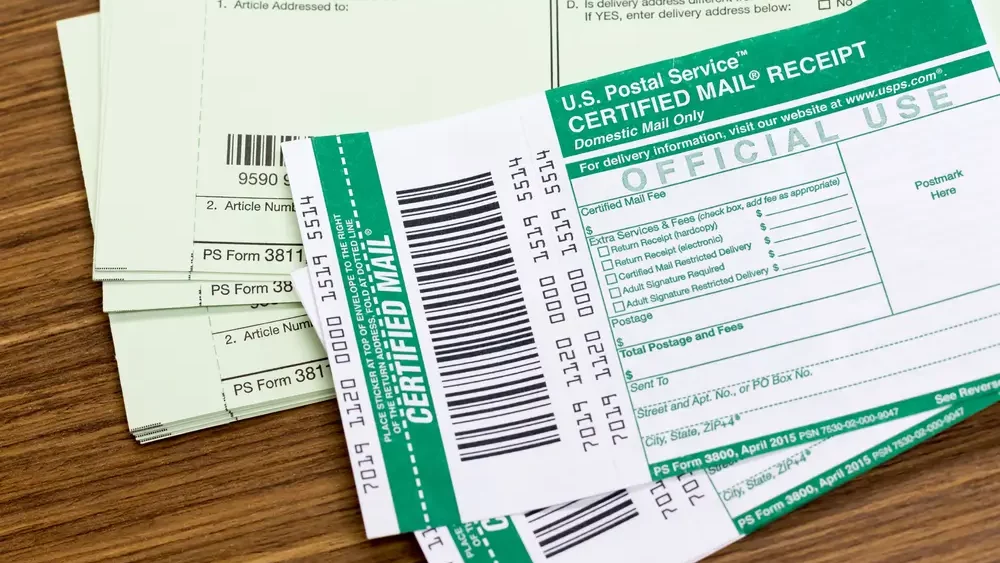
This site is reader-supported. We may earn a small commission if you make a purchase from one of our partners.
Do you need to know how to send a cease and desist letter? If you are reading this, you likely already know that a strongly-worded cease and desist letter is the way to avoid legal action and get the relief you deserve.
So whether you are in the middle of an intellectual property dispute, are the victim of harassment by debt collectors, or want to avoid an expensive law firm for your civil dispute, a strong demand letter can help solve your problem.
For this article, we’ll assume you’ve already decided to send a demand letter and have a draft ready. The following post will review the various ways you can send your letter, along with the pros and cons of each, to help you make an informed decision on delivering it.
If you haven’t started your letter yet and want to learn more about sending one, check out our Ultimate Guide to Cease and Desist Letters to learn everything you need to know about when and how to send them.
Let’s get started.
How To Send A Cease And Desist Letter

There are four primary methods for sending a Cease and Desist letter:
- Serving your letter
- Mailing your letter
- Faxing your letter
- Emailing your letter
It’s essential to choose the correct method for your situation, so you verify delivery and ensure that the recipient feels the weight of the demand you are making.
Let’s look at each of these options in detail.
Method 1: Serving Your Cease and Desist Letter (aka. Hand Delivery)

The first method is to serve your letter. In a recent article, we discussed the differences between “serving” and “sending” your cease and desist letter. In short, serving a cease and desist letter is the process of delivering it in person to the recipient to ensure that they received it.
And while this process is often used for legal documents, it can also be used for both cease and desist and demand letters.
This can happen in one of three ways. They are:
- You deliver it yourself
- You hire a lawyer to deliver it
- You hire a process server to deliver it.
Regardless of which of these serving options you choose, there are benefits and disadvantages to serving your letter.
Benefits Of Serving Your Letter
The primary benefit of serving your letter is that you will have undeniable proof that the recipient received it. This is important for a few reasons:
- It starts the clock on their response time
- It helps to prove in court that they knew about your demand
- It puts pressure on the recipient as they could soon face legal repercussions
There are other benefits as well. For example, it can be a very effective way to get the recipient’s attention since they will likely be surprised when someone shows up to serve them with legal documents.
Lastly, it can also help to build your case if you end up in court, as the act of serving itself can be used as evidence of your efforts to resolve the issue amicably.
Disadvantages Of Serving Your Letter
The main downside of serving your cease and desist letter is the cost. Depending on how you choose to serve it, the cost can range from a few dollars for DIY delivery to hundreds or even thousands of dollars if you hire a lawyer or process server.
Another potential disadvantage is that it could escalate the situation if not done correctly. For example, if you serve someone at their place of business, it could disrupt their operations and cause them to suffer financial damages. This could lead to them countersuing you for those damages.
Lastly, there is always the chance that something could go wrong when delivering the letter. For example, you could get served with a restraining order if the recipient perceives you as a threat.
When Should You Serve A Cease and Desist Letter?
Serving a cease and desist letter is generally a good idea if the recipient is likely to ignore your letter or you can’t reasonably mail it to them. It’s also a good option if you want to apply maximum pressure to get them to comply with your demand.
Method 2: Mailing Your Cease and Desist Letter

The most traditional method of sending a cease and desist letter is to mail it. When mailing your demand letter, you have several options, including:
- Standard mail
- Certified or registered mail
- Courier service (like UPS or FedEx)
When sending your letter in the mail, it is always best to spend the extra few dollars on sending it via certified mail with the return receipt requested. This ensures you get a delivery receipt, guaranteeing the recipient received it. If you want to go even further, you can require a signature on delivery.
Advantages Of Mailing Your Letter
The main advantage of mailing your letter is that it is the most cost-effective method. It is also the most straightforward way to send your letter.
Another benefit is that it gives the recipient time to process the demand you are making and consult with an attorney if they choose to do so. This can help avoid legal proceedings, especially if your demand has merit/legal standing.
Lastly, sending your letter via mail allows you to maintain a low profile as there is no face-to-face interaction between you and the recipient.
Disadvantages Of Mailing Your Letter
The biggest downside of mailing your letter is that you cannot guarantee the recipient will receive it. If they refuse to accept delivery or if it gets lost in the mail, you will have no way of knowing.
Another potential disadvantage is that it could take a few days or weeks for the recipient to receive and respond to your letter. This can be a problem if time is of the essence or if you need an immediate response.
Lastly, mailing your letter removes the element of surprise, which can be beneficial when serving your cease and desist letter in person.
When Should You Mail Your Cease And Desist Letter?
Mailing your cease and desist letter is generally a good idea if you want to avoid conflict or you are trying to resolve the issue amicably. It’s also a good option as it gives the recipient time to consult with an attorney.
Method 3: Faxing Your Cease and Desist Letter

Another option for sending your cease and desist letter is to fax it. This can be a good option if you need to send your letter quickly or if you want to be sure that the recipient received it.
If you choose to send your letter via fax, it is always best to try and send it to a personal/confidential fax machine to avoid prying eyes. It’s also important to note the timestamp and confirmation that your letter was successfully sent and received on the other end.
Advantages Of Faxing Your Letter
The main advantage of faxing your cease and desist letter is that it is quick and easy. It is also a relatively inexpensive method.
Another benefit of faxing your letter is that you can be sure that the recipient’s fax machine received the letter via the electronic delivery confirmation message.
Lastly, sending your letter via fax allows you to maintain a low profile as there is no face-to-face interaction between you and the recipient.
Disadvantages Of Faxing Your Letter
The biggest downside of faxing your letter is that it can be seen as less formal than other delivery methods. This could make the recipient less likely to take your demands seriously.
Another potential disadvantage of faxing your letter is that it may not be private or confidential. If the recipient’s fax machine is in a public place, there is a risk that others may see your letter.
Lastly, faxing your letter removes the element of surprise, which can be beneficial when serving your cease and desist letter in person.
When Should You Fax Your Cease And Desist Letter?
Faxing your cease and desist letter is generally a good idea if you need to send your letter quickly. It’s also a good option to avoid a personal confrontation.
Method 4: Emailing Your Cease and Desist Letter

Emailing your cease and desist letter is another option for delivery. This can be a good choice if you are trying to avoid conflict or if you need to send your letter quickly.
If you choose to send your letter via email, it is always best to turn on the return receipt function as extra proof that the recipient received and opened the message. However, this isn’t foolproof as the recipient can disable it.
Advantages Of Emailing Your Letter
The main advantage of emailing your cease and desist letter is that it is quick and easy. It is also the least expensive method to send your letter.
Another benefit of emailing your letter is that you can CC additional people on the it. For example, if you send a trademark infringement letter, you may want to CC their lawyer or executive team on the message so that they all know that you may pursue legal action.
Lastly, sending your letter via email allows you to maintain a low profile as there is no face-to-face interaction between you and the recipient.
Disadvantages Of Emailing Your Letter
The biggest downside of emailing your letter is that it can be seen as less formal than other delivery methods. This could make the recipient less likely to take your demands seriously.
Another potential disadvantage of emailing your letter is that it may get caught in a SPAM filter or be otherwise undeliverable. When this happens, it’s hard to diagnose the issue and ensure deliverability.
Lastly, emailing your letter removes the element of surprise, which can be beneficial when serving your cease and desist letter in person.
When Should You Email Your Cease And Desist Letter?
Emailing your cease and desist letter is generally a good idea if you need to send your letter quickly or if you need to send it to multiple people at the same time without extra mailing expenses.
Mistakes To Avoid When Sending Your Cease and Desist Letter

When sending your cease and desist letter, there are a few mistakes you’ll want to avoid. These include:
Sending an incomplete letter
Make sure your letter is complete before sending it. This means ensuring you have included all relevant information and corrected all spelling and grammar errors.
Sending an unsigned letter
Always sign your letter before sending it. This will help to ensure that the recipient takes your demands seriously.
Failing to make copies
Make copies of your cease and desist letter before sending it. This way, you’ll have a record of what was sent in case you need to reference it in the future.
Forgetting to date the letter
Always date your letter so there is no confusion about when it was sent. This will be helpful if legal action is necessary down the line.
Failing to follow up
Once you’ve sent your cease and desist letter, be sure to follow up with the recipient. This will help ensure that they take your demands seriously and understand the consequences of failure to comply.
Our Recommendation

If possible, sending your letter via certified mail is always best. This will provide proof of delivery and give you the element of surprise.
If you can’t send your letter via certified mail, then our next recommendation would be to hand-deliver it (either yourself or via a lawyer/process server). This will also help to ensure that the recipient takes your demands seriously.
What to do if you need help writing your Cease and Desist Letter

If you need help writing your cease and desist letter, check out Law Depot. They offer an easy an effective template that can get you the right type of Cease and Desist letter to get the job done.
Conclusion
When sending a cease and desist letter, it is essential to choose the proper method for sending it to avoid the need for further legal action. Mailing your letter is generally a good idea if you need to ensure delivery while serving (hand-delivering) can put the most weight on your response. Regardless of which option you pick, the biggest mistake you can make in your dispute is not sending one.
Good luck!

Wes Talisman is a freelance journalist who helps answer common legal questions for everyday people. He’s never won a Pulitzer Prize, but he does write a stellar Cease and Desist letter.